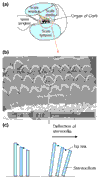Focusing on the genetics of hearing: you ain't heard nothin' yet
- PMID: 12093367
- PMCID: PMC139365
- DOI: 10.1186/gb-2002-3-6-comment2006
Focusing on the genetics of hearing: you ain't heard nothin' yet
Abstract
The complexity of genetic pathways for hearing is beginning to be amenable to unraveling by systematic functional genomic analysis. Genome-wide mutagenesis studies in the mouse are beginning to shed further light on the structure and regulation of the machinery of hearing.
Figures


Similar articles
-
IDS, 2015: You Ain't Seen Nothin' Yet.Dent Today. 2015 Apr;34(4):30. Dent Today. 2015. PMID: 26470558 No abstract available.
-
Vision and action: you ain't seen nothin' yet ..Perception. 1997;26(1):1-6. doi: 10.1068/p260001. Perception. 1997. PMID: 9196685 No abstract available.
-
Medicare cost shifting: you ain't seen nothin' yet.Bus Health. 1990 May;8(5):46, 48-9. Bus Health. 1990. PMID: 10106613 No abstract available.
-
[Molecular biology of hearing].Laryngorhinootologie. 2011 Mar;90 Suppl 1:S22-34. doi: 10.1055/s-0030-1270444. Epub 2011 Apr 26. Laryngorhinootologie. 2011. PMID: 21523631 Review. German.
-
A genetic approach to understanding auditory function.Nat Genet. 2001 Feb;27(2):143-9. doi: 10.1038/84758. Nat Genet. 2001. PMID: 11175778 Review.
Cited by
-
Mouse models as a tool to unravel the genetic basis for human otitis media.Brain Res. 2006 May 26;1091(1):9-15. doi: 10.1016/j.brainres.2006.01.046. Brain Res. 2006. PMID: 16917982 Free PMC article. Review.
-
ClinGen expert clinical validity curation of 164 hearing loss gene-disease pairs.Genet Med. 2019 Oct;21(10):2239-2247. doi: 10.1038/s41436-019-0487-0. Epub 2019 Mar 21. Genet Med. 2019. PMID: 30894701 Free PMC article.
-
A quantitative survey of gravity receptor function in mutant mouse strains.J Assoc Res Otolaryngol. 2005 Dec;6(4):297-310. doi: 10.1007/s10162-005-0009-4. J Assoc Res Otolaryngol. 2005. PMID: 16235133 Free PMC article.
-
Mouse models for human otitis media.Brain Res. 2009 Jun 24;1277:90-103. doi: 10.1016/j.brainres.2009.02.047. Epub 2009 Mar 6. Brain Res. 2009. PMID: 19272362 Free PMC article. Review.
-
Analysis of the mouse mutant Cloth-ears shows a role for the voltage-gated sodium channel Scn8a in peripheral neural hearing loss.Genes Brain Behav. 2009 Oct;8(7):699-713. doi: 10.1111/j.1601-183X.2009.00514.x. Epub 2009 Jun 22. Genes Brain Behav. 2009. PMID: 19737145 Free PMC article.
References
-
- Hudspeth AJ. How hearing happens. Neuron. 1997;19:947–950. - PubMed
-
- Hereditary Hearing Loss homepage http://www.uia.ac.be/dnalab/hhh
-
- Lander ES. The new genomics: global views of biology. Science. 1996;274:536–539. - PubMed
-
- Reich DE, Lander ES. On the allelic spectrum of human disease. Trends Genet. 2001;17:502–510. - PubMed
Publication types
MeSH terms
Substances
LinkOut - more resources
Full Text Sources

